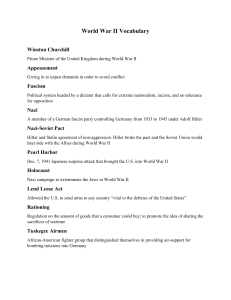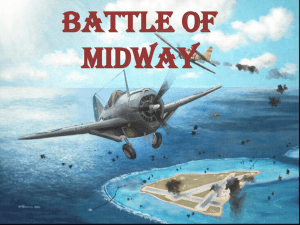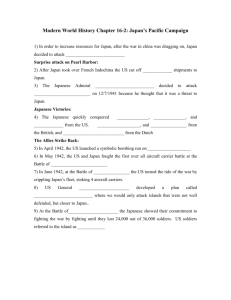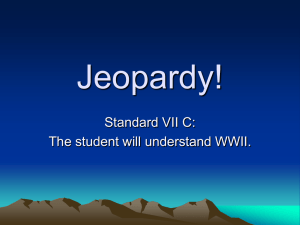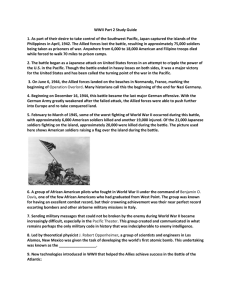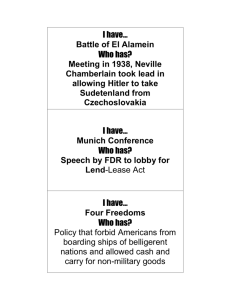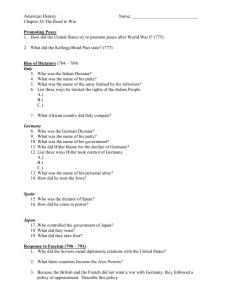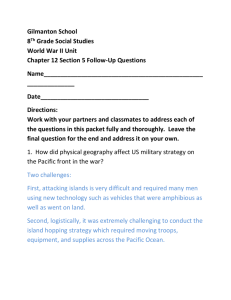The War in the Pacific - Waverly
advertisement
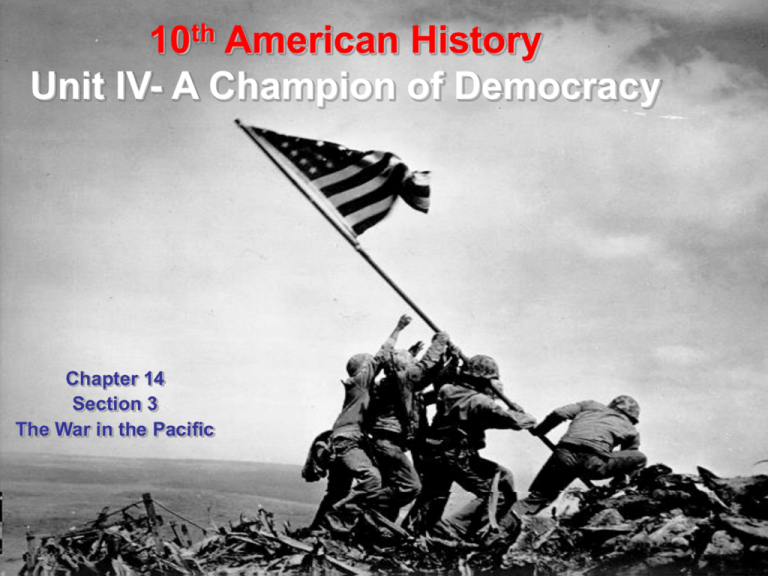
10th American History Unit IV- A Champion of Democracy Chapter 14 Section 3 The War in the Pacific The War in the Pacific The Main Idea After early defeats in the Pacific, the United States gained the upper hand and began to fight its way island by island to Japan. Reading Focus • Why did the Allies experience a slow start in the Pacific? • How did the Allies bring about a shift in their fortunes in the Pacific? • What were the major events that marked Allied progress in the late stages of the Pacific war? A Slow Start in the Pacific • The attack on Pearl Harbor did significant damage to the U.S. Pacific Fleet and it took months to overcome the attack. • The Allies decided to focus their energy and resources on defeating the Axis in Europe. • The Japanese won a quick string of impressive victories following Pearl Harbor. – Drove American forces from Wake Island and Guam – Captured the British stronghold at Hong Kong – Took control of the Dutch East Indies (known as Indonesia today) and British Borneo – Damaged the Allied navies in the Battle of Java Sea – Conquered British-controlled Burma • The Japanese soldiers were highly skilled and well trained. • The Japanese military had excellent equipment. Allied Strategy- 1:21 Active Defense in the Pacific • 1942- Japanese controlled: – – – – – – – Gilbert and Solomon Islands Southern New Guinea Philippines Malaya Singapore Thailand Burma • Allies- Active Defense – – – – Hold on to what remains to them. Need the bases. Secure Hawaii and Somoa Protect the Sea Lanes- Japan had few submarines. A Slow Start for the Allies • Why did the Allies experience a slow start in the Pacific? • Identify – What territories was Japan able to conquer early in World War II? • Analyze – In what ways did the Japanese attack on Pearl Harbor backfire? • Evaluate – Why do you think there was only a small American military force in the Philippines? The Philippines Japan invaded the American-controlled islands of the Philippines in December 1941. General Douglas MacArthur led the defense of the islands. MacArthur’s troops were no match for the Japanese and he retreated to the Bataan Peninsula. Although he called for reinforcements, war planners decided sending ships was too risky. In April 1942, the 10,000 American and 60,000 Filipino troops on Bataan surrendered. Thousands of these captured soldiers died when the Japanese forced them to march through the steaming forests of Bataan. This became known as the Bataan Death March. Allied Advances in the Pacific James Doolittle • Army Lieutenant Colonel • Led a group of 16 American bombers on a daring air raid of Tokyo and several other Japanese cities • Doolittle’s raid did not do major damage to the Japanese targets, but it did give the American people something to celebrate and worried Japan’s leaders. Fortunes Shift in the Pacific • Victory in the Battle of Coral Sea • Victory in the Battle of Midway Doolittle’s Raid on Tokyo • April 18, 1942 • Carrier launched B-52’s attack Tokyo • Not much damage but lifted U.S. morale. James "Jimmy" Doolittle: Pioneering Aviator and Famed World War II Air Commander (02:44) Fortunes Shift in the Pacific Battle of Coral Sea • Japan prepared to invade New Guinea. • U.S. Admiral Chester Nimitz sent two aircraft carriers to stop the attack. • The Americans lost an aircraft carrier in the battle but stopped the Japanese attack. • First time the Japanese advance had been halted Battle of Midway • Japan tried to lure the Americans into a large sea battle around Midway Island. • Naval officers had broken a Japanese code and learned of the plan. • Nimitz devised a plan to thwart the attack and placed his 3 aircraft carriers carefully. • The Americans destroyed 3 of the 4 Japanese carriers and won a major victory. The Early War in the Pacific (01:36) Battle of the Coral Sea- May 7+8 , 1942 • Japanese- Adm. Yamamoto – Force a major sea battle to destroy the Allied Pacific Fleet and invade Australia. – Thus stop any Allied offensive against Japan. • Historic Naval battle – showed Modern Science – Aircraft carrier v. aircraft carrier – Tactical victory went to Japanese- The “box score” – Strategic victory went to U.S.forcing Japan to stop drive toward Australia. – This was the first naval engagement to take place where the opposing ships never fired a shot at each other. Airplane bombers, fighters and torpedo bombers. The Battle of Midway (01:02) Battle of Midway- 1:51 Battle of Midway- June 4-7, 1942 • Fought just a month after the Battle of the Coral Sea, Midway was the turning point of the Pacific Campaign • Yamamoto’s secret plan to surprise the American ships at Midway • With American ships destroyed, – Japan could avenge the bombing of the Japanese home islands. – Japan could plug the hole in their Eastern defensive perimeter and – Japan could perhaps even invade and take Hawaii. • The loss of four carriers stopped the expansion of the Japanese Empire in the Pacific, and put Japan on the defensive. • Balance of naval power now shifts to the U.S.A. Prior to this action, Japan possessed general naval superiority over the United States and could usually choose where and when to attack. After Midway, the two opposing fleets were essentially equals, and the United States soon took the offensive. Battle of Midway Fortunes Shift in the Pacific • How did the Allies bring about a shift in their fortunes in the Pacific? • Recall – How much damage did Doolittle inflict on Tokyo? • Identify Cause and Effect – What were the long-range effects of the U.S. air attack on Tokyo and other Japanese Cities? Fortunes Shift in the Pacific • Explain – What is the significance of the Battle of the Coral Sea? • Summarize – How did the Japanese plan to destroy what remained? • Evaluate – How important was breaking Japanese codes to the overall success of the Allied forces? Allied Progress in the Pacific 1. Gained control of territory in the Solomon Islands to protect Australia 2. Used powerful combination of land, sea, and air forces to capture key islands 3. Captured locations in the Gilbert, Marshall, Caroline, and Mariana islands 4. Took advantage of American industrial power by replacing ships and aircrafts, which Japan was unable to do 5. European successes allowed more resources to be made available in the Pacific. 6. Recaptured the Philippines 7. Captured strategic Japanese islands of Iwo Jima and Okinawa The United States Military "Island Hops" Towards Japan (00:58) General MacArthur: Supreme Allied Commander of the Southwest Pacific Theater in WWII (02:33) The Allies Make Progress Guadalcanal • Allies wanted to gain control of the Solomon Islands to protect Australia. • Key goal was the capture of an island called Guadalcanal • American forces fought for 6 months and finally defeated the Japanese. Navajo Code Talkers • Hundreds of Native Americans of the Navajo nation served in the Marines as code talkers. • They translated messages into a coded version of the Navajo language. • Japanese codebreakers never figured it out. The Philippines • First major battle was the Battle of Leyte Gulf. • The Allies destroyed most of Japan’s fleet. • Japanese began using the kamikaze attack. • After months of fighting, the Allies gained control of the Philippines. August, 1942; The Attack on Guadalcanal (01:07) Battle for Guadalcanal - Aug. 7, 1942 On August 8th, 1942, the Americans began their first counter-attack in the Pacific. The fight for the island was long and bitter, with both sides attempting to reinforce their troops. The American forces, however, were victorious. Finally, in February 1943, the island was secured. The naval battle at Guadalcanal, lasting six months from August, 1942, to February, 1943, was the longest sea battle in history. Iron Bottom Sound was filled with some 100 sunken ships. Disease played a major role in troop effectiveness. Navajo Code Talkers • The Code Talker's primary job was to talk and transmit information on tactics, troop movements, orders and other vital battlefield information via telegraphs and radios in their native dialect. A major advantage of the code talker system was its speed. • Guadalcanal, Tarawa, Peleliu, Iwo Jima: the Navajo code talkers took part in every assault the U.S. Marines conducted in the Pacific from 1942 to 1945. • They served in all six Marine divisions, Marine Raider battalions and Marine parachute units, transmitting messages by telephone and radio in their native language -- a code that the Japanese never broke. World War II: Navajo Code Talkers in the United States Military (02:33) Leyte Gulf and the Philippines • The Battle of Leyte Gulf was the largest naval battle in history. • It was fought during the Pacific Theatre of Operations PTO of World War II, in the seas surrounding the Philippine island of Leyte from 23 October to 26 October 1944 • Between the Allies and the Empire of Japan. • "The Japanese fleet had [effectively] ceased to exist, and, except by land-based aircraft, their opponents had won undisputed command of the sea. When Admiral Ozawa was questioned on the battle after the war he replied 'After this battle the surface forces became strictly auxiliary, so that we relied on land forces, special [Kamikaze] attack, and air power . . there was no further use assigned to surface vessels, with the exception of some special ships.' Japanese Kamikaze Pilots (00:34) Leyte Gulf and the Philippines At the start Navy Large carriers Small Carriers Aircraft Embarked Battleships Cruisers Destroyers United States 8 24 1712 12 24 141 Japan 1 3 117 9 20 34 Navy Large carriers Small Carriers Battleships Cruisers Destroyers Destroyer Escorts US - 3 - - 2 1 Japan 1 3 3 10 11 - Losses The Allies Make Progress • What were the major events that marked Allied progress in the late stages of the Civil War? • Describe – What was Guadacanal? • Analyze – Why were the Solomon Island important to both Japan and the United States? • Elaborate – Why do you think the Americans wanted to capture Guadacanal? The Allies Make Progress • Identify – What was the largest naval battle fought during the war? • Evalate – How did the Japanese kamkaze attacks affect the psychological side of the war? The Yalta Conference- 3:15 The Battles of Iwo Jima and Okinawa (01:07) Iwo Jima's Strategic Location and the Initial Invasion (03:56) Iwo Jima and Okinawa • Explain – What was significant about the Battle of Iwo Jima? • Predict – What do you think might have happened if Japanese troops had surrendered on Okinawa and Iwo Jima?

